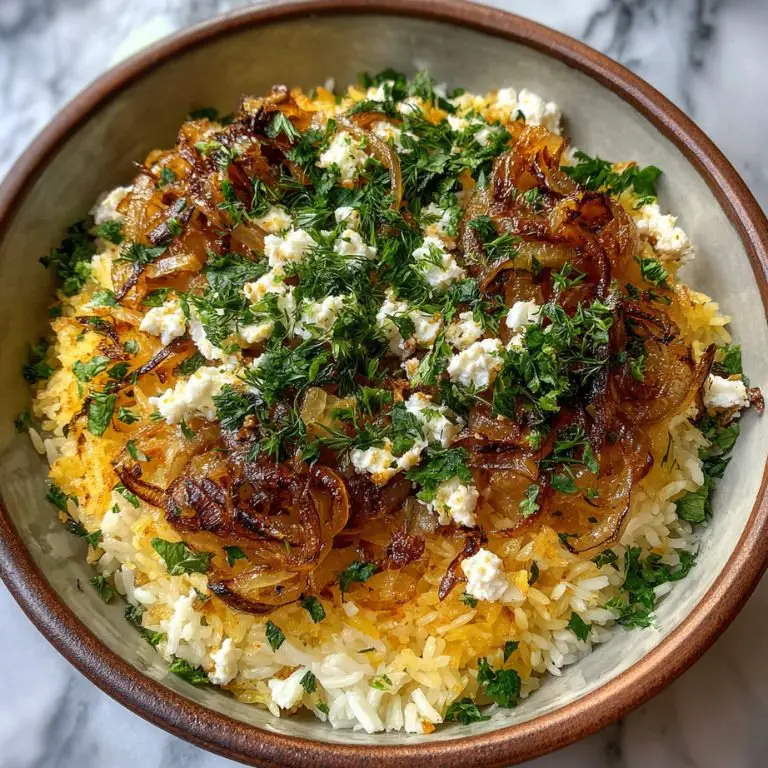There’s something utterly soul-soothing about a warm bowl of Persian rice layered with buttery caramelized onions, creamy crumbles of feta, and a scattering of fresh herbs. This Warm Persian Rice Bowl with Caramelized Onion and Feta is a celebration of texture, flavor, and simplicity—deeply comforting and packed with complexity despite its minimal ingredient list. Whether you’re craving a cozy lunch or assembling a vibrant Persian rice dinner idea for guests, this bowl brings together traditional flavors with modern flair. And best of all, it’s perfect for using up leftover rice, which crisps beautifully at the bottom—hinting at the much-loved tahdig in baked Persian rice.
Warm Persian Rice Bowl with Caramelized Onion and Feta
Prep Time 15 minutes mins
Cook Time 25 minutes mins
Total Time 40 minutes mins
Course Main Course
Cuisine Persian
Heavy-bottomed non-stick or cast iron skillet This helps in achieving the crispy rice bottom without burning.
Chef’s knife and cutting board For prepping onions and herbs.
Spatula or wooden spoon Ideal for stirring onions and flipping rice.
Small bowl (optional) To soak cherries or barberries.
Lid for pan or foil To steam the rice slightly before serving.
For the Rice Bowl
- 2 cups cooked basmati rice preferably a day old for best texture
- 2 medium yellow onions thinly sliced
- 2 tbsp unsalted butter
- 2 tbsp olive oil extra virgin preferred
- 1/2 tsp ground turmeric
- Salt and pepper to taste
- 3 oz crumbled feta cheese
- 1/4 cup chopped fresh parsley
- 1/4 cup chopped fresh dill
- 2 tbsp chopped fresh mint
- 1/2 lemon for juice
Optional Add-ons
- Handful of dried barberries or dried cherries soaked in warm water for 10 minutes
- 1/4 cup toasted walnuts or slivered almonds
- Dollop of Persian yogurt salad mast-o-khiar
Prepare the Onions
In your skillet, heat the butter and 1 tablespoon of olive oil over medium heat. Once hot, add the thinly sliced onions with a generous pinch of salt. Stir occasionally and cook for 15–20 minutes until the onions are deeply golden and caramelized. If they start to brown too fast, reduce the heat to medium-low. This slow caramelization adds intense umami and sweetness to the dish.
Crisp the Rice
While the onions are cooking, mix your leftover rice with turmeric, a pinch of salt, and the remaining tablespoon of olive oil. Once the onions are caramelized, transfer half to a plate and leave the rest in the pan. Add the rice directly over the onions, patting it down slightly to increase surface contact. Let it cook undisturbed on medium heat for 6–8 minutes until the bottom becomes golden and slightly crispy—this mimics the crust of tahdig found in baked Persian rice.
Steam and Warm
Lower the heat and cover the skillet with a lid or foil. Let the rice steam for another 5 minutes. This ensures the upper layers are warm and soft while the bottom retains its crispiness.
Assemble the Bowl
Spoon the crispy rice into serving bowls. Top with the reserved caramelized onions, crumbled feta, and chopped herbs. Squeeze a bit of fresh lemon juice over everything for brightness. If using, scatter in the soaked cherries or barberries and add nuts for crunch.
Serve Immediately
This bowl is best served warm, either as a vegetarian main or a side to heartier dishes like a Persian stew with rice and salad or grilled meats.
Pairings
This rice bowl pairs beautifully with a Persian shirazi salad—a refreshing mix of cucumber, tomato, and onion dressed in lemon and olive oil. The brightness cuts through the rich onions and feta perfectly. Alternatively, a spoonful of Persian herb salad with yogurt or Persian-style rice salad with cherries can add variety to your plate, especially if you're planning a spread of Persian rice dinner ideas.
For a full meal, consider pairing this with a light Persian yogurt salad and a simple Iranian salad recipe like mast-o-khiar. It also holds up wonderfully next to a medley of Mediterranean recipes or even as a vegetarian side dish to grilled meats, falafel, or stews.
Wine-wise, a dry white like Sauvignon Blanc or a chilled Rosé pairs nicely. For non-alcoholic options, mint tea or a cucumber-yogurt drink (doogh) keeps the meal refreshingly traditional.
FAQs
1. Can I use freshly cooked rice instead of leftover rice?
Yes, but leftover rice is ideal as it holds its shape and crisps up better. If using fresh rice, let it cool for at least 30 minutes to dry out slightly. This step is crucial to avoid a mushy texture.
2. What kind of rice is best for Persian rice bowls?
Long-grain basmati rice is preferred for its aroma and texture. You can use jasmine rice in a pinch, but it won’t have the same fluffiness or Persian authenticity as basmati.
3. Is this dish vegetarian?
Absolutely! This recipe is fully vegetarian and aligns with many receitas vegetarianas (vegetarian recipes). You can also make it vegan by swapping feta for a plant-based alternative and using plant-based butter or just olive oil.
4. How to make Persian yogurt salad to serve with this?
To make a quick Persian yogurt salad (mast-o-khiar), mix Greek yogurt with chopped cucumber, dried mint, a touch of garlic, salt, and a drizzle of olive oil. Garnish with dried rose petals or crushed walnuts for an elegant twist.
5. How can I reuse leftovers of this rice bowl?
This dish reheats well and can be turned into a rice salad the next day. Just toss the cold rice with extra herbs, a bit of olive oil, lemon juice, and maybe even diced cucumbers for a Persian-inspired lunch bowl. It’s a smart and tasty way to manage carbs in rice while keeping your meals interesting.
